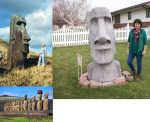The Walking Moai
Monday, December 30, 2013

Patty Keene with her Easter Island Moai replica; Thor Heyerdahl on Easter Island.
Most of us, when we move to a new location, like to keep a few reminders around of the place we left behind. Usually these keepsakes consist of pictures, or bedspread, or some personal keepsake. But for Patty Keene, of McCook, that was not enough. She keeps a 6' high replica of one of the stone statues, which are so closely identified with Easter Island, a part of her home country of Chile, in South America. This striking stone figure is prominently displayed in the front yard of her home, in north McCook. Patty had only recently installed her Moai when it mysteriously transplanted itself onto her neighbor's lawn. She immediately thought of the old Easter Island legend of "The Walking Moais".
For as long as western explorers have been in contact with Easter Island, these stone figures have been a source of much controversy. Scientists just cannot agree as to the origin of the stone figures, what they signified, or how they were moved. Every few years a new theory surfaces concerning various aspects of the figures and the early Easter Island Culture.
Authorities now are in quite general agreement that the Moai were figures of native Gods, carved by the Rapa Nui, on Easter Island between the years of AD 1250-1500. The stone figures were already old, in place, and had been toppled over when the island was "discovered" by the English explorer, Captain Cook, in 1774.
Easter Island, one of the remotest places on earth, had been visited on at least two other occasions by European visitors, the Dutch in 1722, and the Spanish in 1770. Neither of these expeditions had any lasting effect on Easter Island and its inhabitants, though the Dutch, having landed on Easter day, gave the Island its name. At the time of the Dutch visit Easter Island had perhaps as many as 10,000 inhabitants, but subsequent visits by Europeans brought slave traders who captured many of the island natives and carted them off to Europe, the United States, and Peru. The Europeans also introduced tuberculosis, smallpox and dysentery to the island, further decreasing the island's population. All this, plus internal fighting between competing island clans, almost wiped out the native population of Easter Island. By the 1880s the native population of the island had shrunk to 111, and most of these were past child-bearing age.
Since 1888 Easter Island has been a province of Chile---Easter Island is about the same distance from the mainland of Chile as Hawaii is from mainland United States. Since that time the native population of the island has gradually come back, and today totals about 5,700. Unfortunately, during those dark days of the 1700s, most of the native history was lost, leaving the island's mysteries open to speculation by Anthropologists---no mystery more appealing than the intriguing riddle of the strange Moia figures.
The Moai figures of Easter Island are real. That is certain. They are still on the island, and most are again standing. Though most of the Moai are full figures, one third to one half of the statue is the head, leading to descriptions of the statues as "Moai Heads". How they were carved, and why, what they signified, and how they were moved is still somewhat of a mystery. Most of the statues came from one main quarry on the island. More than 850 of the statues have been moved from the quarry, to sit on stone bases at locations around the island, always facing the interior. They are huge, some weighing over 85 tons, and as much as 33 feet tall. There is one unfinished statue at the quarry that if completed would be 69 feet tall and weigh in excess of 270 tons! Much of the controversy about the Moia is how a relatively primitive people, without the use of wheels and pulleys could have moved the statues from the quarry to their platforms on the seacoast. The answer for some folks has been that supernatural forces engineered the carving and the moving of the stone figures. The lingering local folklore said that the Moai had walked from their quarry birthplace to their posts at the edge of the island.
For many years the prevailing theory regarding the movement of the great stone figures revolved around one or another method, all of which involved a type of sled, made of palm trees, on which the stone figures were attached in a prone position, and having been dragged over wooden rollers from the quarry to their permanent locations. For this to happen it was estimated that the work would have required the combined muscle power of as many as 1,500 people. Anthropologists had moved some of the smaller figures by this method, to prove that it could have been done. Still, there persisted that troubling legend of the Easter Island natives that the Moai "walked" to their destination. Hmm!
In 1955 Thor Heyerdahl, the great Norwegian Anthropologist of Kon Tiki fame, did the definitive archaeology work on Easter Island, in which he clearly defined the three distinct eras of Easter Island history, from the time when Easter Island was a verdant land, covered with dense palm tree forests and vegetation, to the era when the great stone figures were carved and put into place, and finally the period of island warfare, when most of the descendants of the original settlers of Easter Island were destroyed and the Moai were toppled.
During Heyerdahl's time of study on Easter Island he tackled the mystery of how the great stone figures were moved. At first he had 180 islanders, using two parallel ropes attached to either side, move a rather small, 9', 8 ton figure some distance using the roller method, with the skids greased with sweet potatoes, taro roots, and palm leaves. Even as he was completing the demonstration an Easter Island native told him he was completely wrong and he should try another method. This time Heyerdahl agreed and his subsequent explanation was that the Moai could have been moved, in an upright position by a relatively small crew (16 people), using ropes attached near the top of the head, one to either side, a third rope leading to the rear for stabilization. These teams would alternately pull the statue to one side, then the other, slightly tipping the statue forward, and at the same time moving it ahead, a few inches at a time. When Heyerdahl's team demonstrated the movement in this fashion (on admittedly small, 13', 10 ton figure), it did appear that the Moai was "walking" along to its final destination.
Since Heyerdahl's initial demonstration other Anthropologists have refined his method, and though certainly not everyone is in agreement that this is the final answer, today we can witness a walking Moai. For a demonstration of a "Walking Moai" one can go to Anthropology.net, "Walking the Moai" June 2012, to view a National Geographic demonstration of a walking Moai---a wonderful example of the ingenuity of an unsophisticated people, using the resources at hand to pull off an "impossible" task. .
Patty is not buying the notion that her Moai is one of the "Walking Moais". She rather favors the theory of "Strong Arm McCook Teenagers", but whatever the explanation, the Legend of the Walking Moais is alive and well in McCook.
Source: Moving the Moai, Anthropology.net
Thor Heyerdahl -- Easter Island
History of Easter Island

